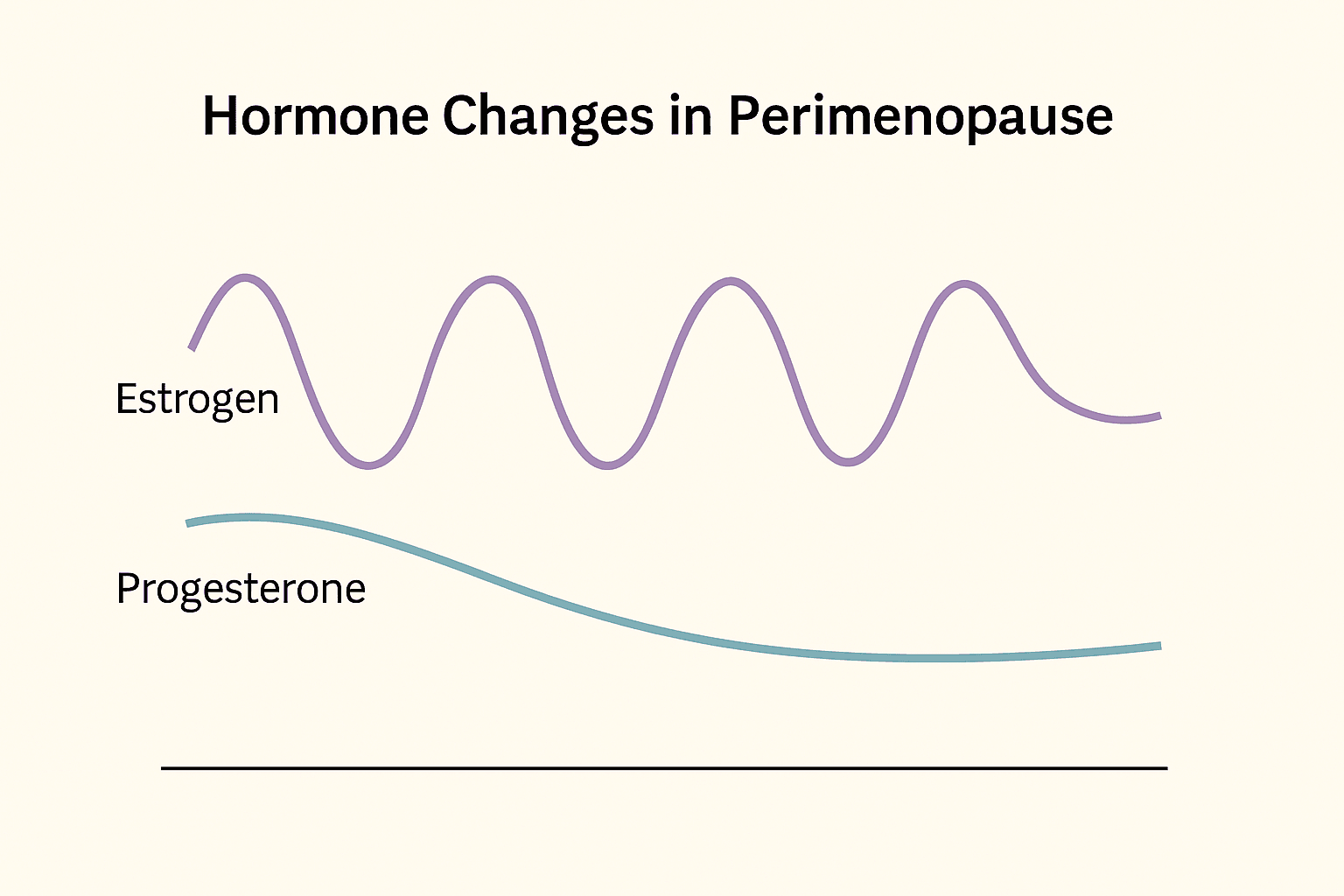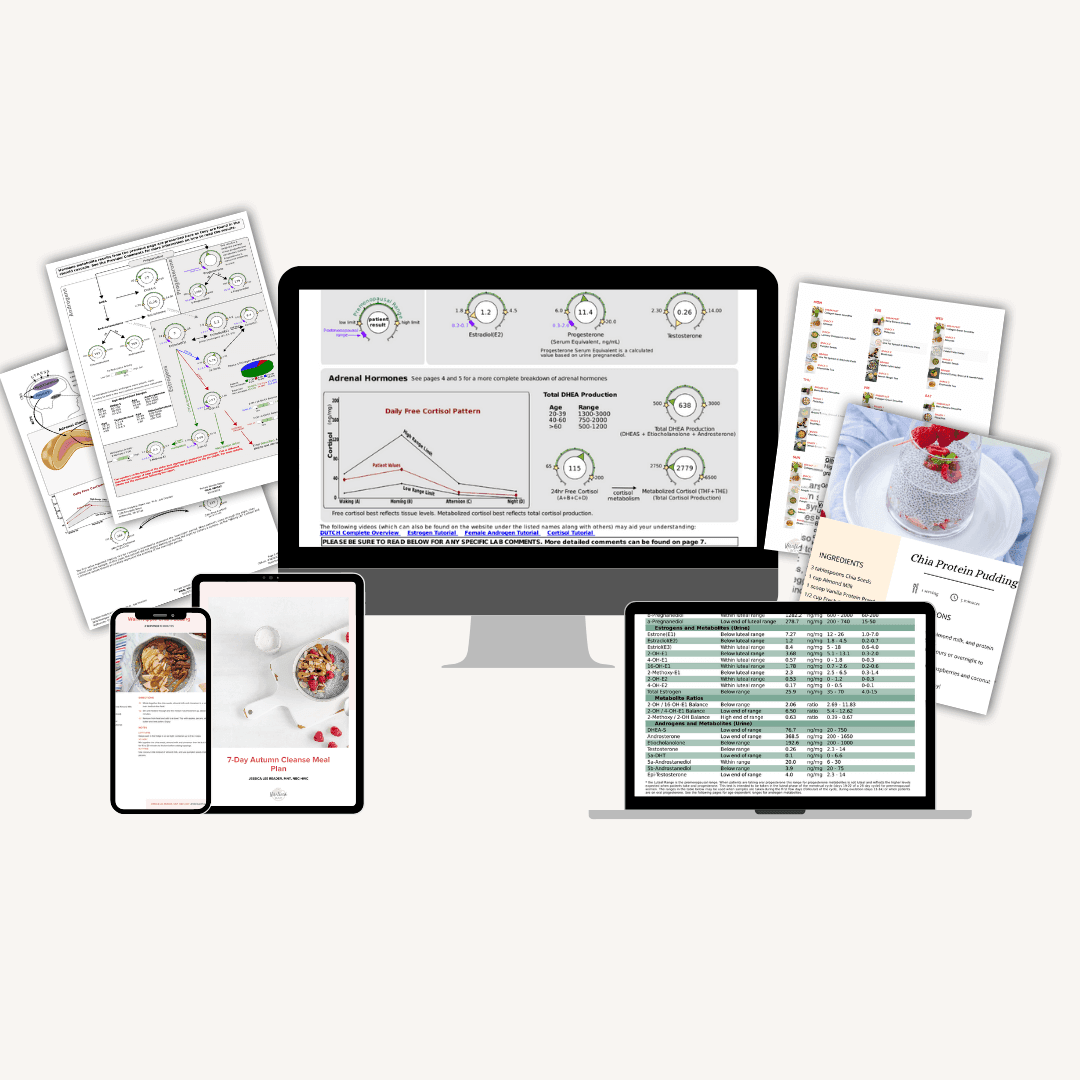Learn How to Test for Perimenopause
And why it matters more than you think.
What Women Are Asking About Perimenopause:
Supplements, Food, and Symptoms
New clients ask me all the time, “What supplements should I take, and what should I eat to help with my symptoms?”
They’re suffering from hot flashes that jolt them awake at 2 a.m., drenched in sweat and heart racing. Night sweats that leave them anxious and wired but exhausted. Mood swings that make them snap at people they love. Weight gain that shows up overnight, especially around the belly, even though nothing has changed. Brain fog that makes it hard to finish a sentence, let alone remember why they walked into a room.
They’re desperate for relief—and I get it.
But here’s the thing I always tell them: trying random supplements—or changing your diet based on generic advice—without knowing what your hormones are doing is like throwing darts blindfolded.
Sometimes, it makes things worse.
What Is Estrogen Dominance in Perimenopause?
In perimenopause, your hormones are fluctuating wildly. Taking something like maca, which can stimulate estrogen, might increase symptoms if you’re already estrogen dominant. And estrogen dominance is incredibly common in perimenopause.
Estrogen dominance means you have too much estrogen relative to progesterone.
Estrogen doesn’t have to be high to cause issues.
If progesterone is too low, estrogen can become dominant.
This can cause:
Heavy, painful periods
Breast tenderness
Mood swings and anxiety
Bloating & weight gain around mid-section
Other contributing factors include:
Chronic stress, which lowers progesterone
Poor detoxification through the liver and gut
Environmental exposures to xenoestrogens (from plastics, personal care products, etc.)
Without proper testing, it’s easy to take the wrong supplements—or eat the wrong foods—and worsen these symptoms.
Even foods can backfire if you’re not careful. For example, phytoestrogens like soy and flaxseed can be helpful in some cases—but if your estrogen is already elevated and not clearing well, they could worsen symptoms. On the flip side, some women actually need more of those foods for support.
That’s why I don’t recommend guessing—not with supplements, and not with food.
So before you reach for that supplement or cut out entire food groups, let’s talk about what perimenopause actually is, what the symptoms are, and how to test intelligently so you can finally feel like yourself again.
What Is Perimenopause (and Why Does It Feel So Confusing)?
Perimenopause is the transition phase before menopause. It can begin as early as your late 30s and often lasts anywhere from 4 to 10 years.
The hallmark? Fluctuating hormones. Your estrogen and progesterone start to shift—not in a linear, predictable way, but in a rollercoaster that affects every system in your body.
There are over 34 documented symptoms of perimenopause, and they can vary wildly from woman to woman

Common Symptoms of Perimenopause
- Fatigue
- Weight gain, especially around the belly
- Mood swings
- Anxiety or irritability
- Sleep issues
- Irregular periods
- Brain fog
- Bloating
- Low libido
No two midlife bodies are the same—which is exactly why testing matters.
Can You Test for Perimenopause?
There is no single test that will definitively say, “You’re in perimenopause.”
But that doesn’t mean testing isn’t useful.
Common Blood Tests for Perimenopause
- Estrogen: A key reproductive hormone that supports bone health, brain function, and mood. It can fluctuate dramatically in perimenopause.
- Progesterone: Helps balance estrogen and supports calm, sleep, and cycle regulation. Progesterone levels often drop first.
- Cortisol: Your primary stress hormone. When it’s dysregulated, it impacts sleep, weight, mood, and hormone balance.
- LH (Luteinizing Hormone): Helps regulate ovulation. Levels can spike or become erratic in perimenopause.
The challenge? These levels change depending on your cycle, stress, and even time of day—making them less reliable on their own. This is where the DUTCH test (Dried Urine Test for Comprehensive Hormones) comes in.
What Is the DUTCH Test
Unlike standard blood tests, DUTCH provides a full-day picture of:

- Estrogen, progesterone, testosterone
- Cortisol throughout the day
- DHEA and melatonin
- Hormone detox pathways
It doesn’t diagnose perimenopause. Instead, it helps us see patterns, imbalances, and where support is needed—so we can build a plan that actually works.
You can order the DUTCH test through me and receive a full 1:1 review with personalized nutrition, nervous system support, and lifestyle guidance based on your results.
Why Guessing Can Backfire
When you self-prescribe without knowing your hormone patterns, you risk making things worse.
Taking supplements that push estrogen when you’re already estrogen dominant can increase symptoms like bloating, anxiety, and breast tenderness.
Eating more phytoestrogens when your estrogen is already high and not clearing well can lead to further imbalance. Taking calming herbs when your cortisol is already bottomed out can lead to more fatigue and brain fog.
Knowledge is power. Testing gives you that.
You Deserve a Plan That’s Based on Your Body
Perimenopause isn’t something to fix—but it is something to understand. And support.
When we work together, I help you:
- Identify your hormone patterns with targeted testing (like DUTCH)
- Create a personalized nutrition plan that supports hormonal balance
- Use nervous system tools (like yoga, breathwork, and daily rituals) to reduce stress and support recovery
You’re not broken. You’re shifting. And you don’t have to do it alone.

Got questions about your hormones?
If you’re feeling bloated, tired, moody, or just not like yourself, you’re not alone—and you’re not stuck.
Book a free consult today and let’s talk about whether hormone testing is right for you.
You deserve to feel steady, clear, and supported in your 40s and beyond.
